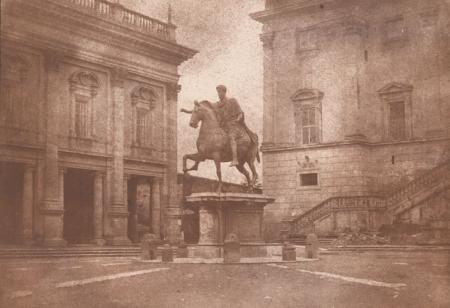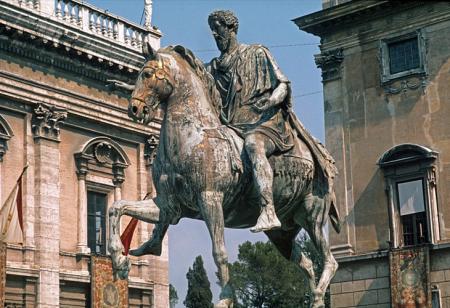
1843

1974
I walked down by the back streets to the steps mounting to the Capitol... Above, in the piazzetta before the stuccoed palace which rises so jauntily on a basement of thrice its magnitude, are... loungers and knitters in the sun, seated round the massively inscribed base of the statue of Marcus Aurelius. Hawthorne has perfectly expressed the attitude of this admirable figure in saying that it extends its arm with “a command which is in itself a benediction.” I doubt if any statue of king or captain in the public places of the world has more to commend it to the general heart. Irrecoverable simplicity—residing so in irrecoverable Style—has no sturdier representative. Here is an impression that the sculptors of the last three hundred years have been laboriously trying to reproduce; but contrasted with this mild old monarch their prancing horsemen suggest a succession of riding-masters taking out young ladies’ schools. The admirably human character of the figure survives the rusty decomposition of the bronze and the slight “debasement” of the art; and one may call it singular that in the capital of Christendom the portrait most suggestive of a Christian conscience is that of a pagan emperor.
—Henry James, Italian Hours, 141–142
The calotype process allowed multiple prints to be made from a single paper negative, representing an advance on the daguerreotype process, which produced a single image. The subject of Jones’s salt print, the equestrian monument of Marcus Aurelius, is the centerpiece of the Piazza del Campidoglio. Jones angled and positioned the camera to silhouette the statue against the open sky. Unlike many calotypists, Jones did not block out the sky to correct for the oversensitivity of the photographic salts to blue light. As a result, the speckled cloudlike effect in the sky imbues this print with a special aura.
Calvert Richard Jones, The Equestrian Monument of Marcus Aurelius on the Capitoline Hill, 1846 Collection W. Bruce and Delaney H. Lundberg. Photography by Graham S. Haber
Location photography by John Pinto
